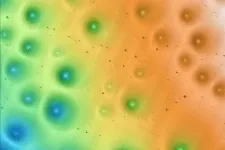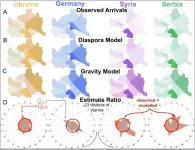(Press-News.org) Hope for a cure for visceral leishmaniasis, an often fatal infectious disease
A discovery by Simona Stäger’s team could help come up with a treatment to the most serious form of leishmaniasis.
Leishmaniasis is a tropical disease affecting a growing number of people worldwide. Each year, between 700,000 and 1 million new cases are reported. Caused by a protozoan parasite of the genus Leishmania, which is transmitted to humans by the simple bite of a sand fly, leishmaniasis comprises three clinical forms, of which the visceral form is the most serious. If left untreated, visceral leishmaniasis, also known as black fever, is almost always fatal. Most cases occur in Bangladesh, Brazil, Ethiopia, India, Nepal, and Sudan.
Professor Simona Stäger of the Institut national de la recherche scientifique (INRS) and her team, in collaboration with other researchers from INRS and McGill University, have observed a surprising immune mechanism linked to chronic visceral leishmaniasis. This discovery could be an important step towards a new therapeutic approach to this disease. The results of their research have been published in the journal Cell Reports.
In many infections, CD4 T cells play a key role in defending the affected organism. Unfortunately, in the case of chronic infections such as leishmaniasis, maintaining the number of functional CD4 cells becomes an important issue, as the immune system is constantly activated to react against the pathogen affecting the infected person.
New immunity soldiers to the rescue
However, the study carried out by Professor Stäger in her laboratory at INRS’s Armand-Frappier Santé Biotechnologie Research Centre suggests that these cells may have more than one trick up their sleeve to maintain their vitality.
“We have discovered a new CD4 cell population in mice infected with the parasite responsible for visceral leishmaniasis. These T cells have interesting properties.”
— Simona Stäger, expert in immunology of infectious diseases
By observing these novel cells, the scientists noticed that they increase in number during the chronic phase of the disease and also that, like progenitor cells, they are capable of self-renewal or differentiation into other effector cells responsible for eliminating the parasite, or regulatory cells that inhibit the host’s response.
Professor Simona Stäger points out that CD4 T cells normally differentiate into effector cells from “naive” CD4 T cells. But during chronic infections, because of the constant need to generate effector cells, naive CD4 T cells are highly solicited and may become exhausted.
“We believe that in the chronic phase of visceral leishmaniasis, the new population we have identified is responsible for generating effector and regulatory cells. This would allow the host to prevent exhaustion of its existing pool of naive CD4 Tcells for a certain antigen,” explains Ph.D. student and first author of the study, Sharada Swaminathan.
The new lymphocyte population discovered by the INRS team could be a decisive immune booster, taking over from over-solicited naive CD4 T cells.
“If we can figure out how to direct this new lymphocyte population to differentiate into a protective effector cell, it could help the host get rid of the Leishmania parasite.”
— Simona Stäger, Vice-Director of the Infectiopole and member of Pasteur Network
A cure for other infections?
The study also mentions that cells similar to this new CD4 T lymphocyte population have been observed in mice infected with lymphocytic choriomeningitis virus and in mice carrying the H. polygyrus intestinal worm. So it is quite possible that this population is present in other chronic infections or in other chronic inflammatory environments.
This overlap sets the stage for an even wider scope for the discovery made by Professor Stäger’s team. “If our hypothesis is correct, these cells could be exploited therapeutically not only for visceral leishmaniasis, but also for other chronic infections,” concludes the researcher.
About the article
This article was co-authored by Sharada Swaminathan, Linh Thuy Mai, Alexandre P. Meli, Liseth Carmona-Pérez, Tania Charpentier, Alain Lamarre, Irah L. King, and Simona Stäger. Entitled “LAG-3- and CXCR5-expressing CD4 T cells display progenitor-like properties during chronic visceral leishmaniasis”, it was published in Cell Reports. DOI : 10.1016/j.celrep.2024.113879
This research was funded by the Canadian Institutes of Health Research (CIHR).
Hope for a cure for visceral leishmaniasis, an often fatal infectious disease
A discovery by Simona Stäger’s team could help come up with a treatment to the most serious form of leishmaniasis.
Leishmaniasis is a tropical disease affecting a growing number of people worldwide. Each year, between 700,000 and 1 million new cases are reported. Caused by a protozoan parasite of the genus Leishmania, which is transmitted to humans by the simple bite of a sand fly, leishmaniasis comprises three clinical forms, of which the visceral form is the most serious. If left untreated, visceral leishmaniasis, also known as black fever, is almost always fatal. Most cases occur in Bangladesh, Brazil, Ethiopia, India, Nepal, and Sudan.
Professor Simona Stäger of the Institut national de la recherche scientifique (INRS) and her team, in collaboration with other researchers from INRS and McGill University, have observed a surprising immune mechanism linked to chronic visceral leishmaniasis. This discovery could be an important step towards a new therapeutic approach to this disease. The results of their research have been published in the journal Cell Reports.
In many infections, CD4 T cells play a key role in defending the affected organism. Unfortunately, in the case of chronic infections such as leishmaniasis, maintaining the number of functional CD4 cells becomes an important issue, as the immune system is constantly activated to react against the pathogen affecting the infected person.
New immunity soldiers to the rescue
However, the study carried out by Professor Stäger in her laboratory at INRS’s Armand-Frappier Santé Biotechnologie Research Centre suggests that these cells may have more than one trick up their sleeve to maintain their vitality.
“We have discovered a new CD4 cell population in mice infected with the parasite responsible for visceral leishmaniasis. These T cells have interesting properties.”
— Simona Stäger, expert in immunology of infectious diseases
By observing these novel cells, the scientists noticed that they increase in number during the chronic phase of the disease and also that, like progenitor cells, they are capable of self-renewal or differentiation into other effector cells responsible for eliminating the parasite, or regulatory cells that inhibit the host’s response.
Professor Simona Stäger points out that CD4 T cells normally differentiate into effector cells from “naive” CD4 T cells. But during chronic infections, because of the constant need to generate effector cells, naive CD4 T cells are highly solicited and may become exhausted.
“We believe that in the chronic phase of visceral leishmaniasis, the new population we have identified is responsible for generating effector and regulatory cells. This would allow the host to prevent exhaustion of its existing pool of naive CD4 Tcells for a certain antigen,” explains Ph.D. student and first author of the study, Sharada Swaminathan.
The new lymphocyte population discovered by the INRS team could be a decisive immune booster, taking over from over-solicited naive CD4 T cells.
“If we can figure out how to direct this new lymphocyte population to differentiate into a protective effector cell, it could help the host get rid of the Leishmania parasite.”
— Simona Stäger, Vice-Director of the Infectiopole and member of Pasteur Network
A cure for other infections?
The study also mentions that cells similar to this new CD4 T lymphocyte population have been observed in mice infected with lymphocytic choriomeningitis virus and in mice carrying the H. polygyrus intestinal worm. So it is quite possible that this population is present in other chronic infections or in other chronic inflammatory environments.
This overlap sets the stage for an even wider scope for the discovery made by Professor Stäger’s team. “If our hypothesis is correct, these cells could be exploited therapeutically not only for visceral leishmaniasis, but also for other chronic infections,” concludes the researcher.
About the article
This article was co-authored by Sharada Swaminathan, Linh Thuy Mai, Alexandre P. Meli, Liseth Carmona-Pérez, Tania Charpentier, Alain Lamarre, Irah L. King, and Simona Stäger. Entitled “LAG-3- and CXCR5-expressing CD4 T cells display progenitor-like properties during chronic visceral leishmaniasis”, it was published in Cell Reports. DOI : 10.1016/j.celrep.2024.113879
This research was funded by the Canadian Institutes of Health Research (CIHR).
END
Hope for a cure for visceral leishmaniasis, an often fatal infectious disease
A discovery by INRS research team could help come up with a treatment to the most serious form of leishmaniasis
2024-05-21
ELSE PRESS RELEASES FROM THIS DATE:
How AI helps programming a quantum computer
2024-05-21
Generative models like diffusion models are one of the most important recent developments in Machine Learning (ML), with models as Stable Diffusion and Dall.e revolutionizing the field of image generation. These models are able to produce high quality images based on some text description. “Our new model for programming quantum computers does the same but, instead of generating images, it generates quantum circuits based on the text description of the quantum operation to be performed”, explains Gorka Muñoz-Gil from the Department of Theoretical Physics of ...
New research reveals that prehistoric seafloor pockmarks off the California coast are maintained by powerful sediment flows
2024-05-21
New MBARI research on a field of pockmarks—large, circular depressions on the seafloor—offshore of Central California has revealed that powerful sediment flows, not methane gas eruptions, maintain these prehistoric formations. A team of researchers from MBARI, the United States Geological Survey (USGS), and Stanford University published their findings today in the Journal of Geophysical Research: Earth Surface. This work provides important information to guide decision-making about responsible use and management of the seafloor off California, including site assessments for the development of offshore wind farms.
The Sur Pockmark Field—an area about the size ...
AI can help improve ER admission decisions, Mount Sinai study finds
2024-05-21
New York, NY [May 21, 2024]—Generative artificial intelligence (AI), such as GPT-4, can help predict whether an emergency room patient needs to be admitted to the hospital even with only minimal training on a limited number of records, according to investigators at the Icahn School of Medicine at Mount Sinai. Details of the research were published in the May 21 online issue of the Journal of the American Medical Informatics Association (JAMIA/DOI: 10.1093/jamia/ocae103).
In the retrospective study, the researchers analyzed records from seven Mount Sinai Health System hospitals, using both structured data, such as vital signs, ...
Matcha mouthwash inhibits bacteria that causes periodontitis
2024-05-21
Highlights:
Periodontitis is linked to tooth loss and other health concerns.
Past studies suggest that green tea products can act against P. gingivalis, which causes periodontitis.
In a new study, researchers tested matcha extract, made from green tea, against the pathogen.
Lab studies suggest matcha inhibits the growth of the bacteria.
A clinical trial showed that matcha mouthwash inhibited P. gingivalis populations in saliva.
Washington, D.C.—Periodontitis is an inflammatory gum disease driven by bacterial infection and left untreated it can lead to complications including tooth loss. ...
Oncology events in Poland solidify collaboration with NCCN
2024-05-21
WARSAW, POLAND [May 21, 2024] — The National Comprehensive Cancer Network® (NCCN®)—a global nonprofit responsible for leading cancer treatment guidelines—is taking part in two events in Warsaw focused on advancing cancer care and highlighting the Poland-US bilateral achievements in health care from May 21-22, 2024. The meetings will be organized by Maria Sklodowska-Curie National Research Institute of Oncology, the Polish Oncological Society, and the Alliance for Innovation. ...
City of Hope awarded $5.4 million CIRM grant to create a stem cell laboratory and expand access to state-of-the-art disease models and technology among a diverse scientific community
2024-05-21
LOS ANGELES — City of Hope®, one of the largest cancer research and treatment organizations in the United States, has been awarded $5.4 million from the California Institute for Regenerative Medicine (CIRM) to build and fund a stem cell research laboratory on its Duarte, California, campus that will further expand its scientific capabilities.
The mission of the unique Stem Cell-Based Disease Modeling Laboratory is two-fold. First, it will advance stem cell-based disease modeling to spur innovation in regenerative medicine. The laboratory leverages City of Hope’s infrastructure ...
Meeting preview: Hot topics at NUTRITION 2024
2024-05-21
Thousands of top nutrition experts will gather next month for a dynamic program of research announcements, policy discussions and award lectures at NUTRITION 2024, the annual flagship meeting of the American Society for Nutrition. Reporters and bloggers are invited to apply for a complimentary press pass to attend the meeting in Chicago from June 29–July 2.
Explore the meeting schedule and register for a press pass to attend.
Hot topics to be explored at NUTRITION 2024 include:
Diet and cancer ...
Study models how ketamine’s molecular action leads to its effects on the brain
2024-05-21
A World Health Organization Essential Medicine, ketamine is widely used at varying doses for sedation, pain control, general anesthesia and as a therapy for treatment-resistant depression. While scientists know its target in brain cells and have observed how it affects brain-wide activity, they haven’t known entirely how the two are connected. A new study by a research team spanning four Boston-area institutions uses computational modeling of previously unappreciated physiological details to fill that gap and offer new insights into how ketamine works.
“This modeling work has helped decipher likely mechanisms through which ...
A diaspora-based model of human migration
2024-05-21
How do migrants choose their destinations? Existing models, known as “gravity models,” use population size and travel distance as explanatory variables—and often fail, especially at the neighborhood scale. Many migrants prefer to move to a location near friends, family, or co-nationals. This pattern might be partly driven by factors that repeat (such as the cost of living) and partly driven by homophily, the tendency to interact with similar others. Early migrants tend to reduce uncertainty and provide information for later arrivals. Building on these observations, Rafael Prieto-Curiel and colleagues construct a migration model based on the power of the diaspora to ...
Black and Hispanic Americans experience wider temperature swings
2024-05-21
Extreme heat can harm human health, but so can temperature extreme swings. Large daily temperature variation (DTV) has been associated with elevated mortality in studies around the world. Trees and other vegetation can lower DTV, as trees reduce temperature through transpiration during the day and also trap long-wave radiation in the atmosphere under the canopy at night, increasing temperature. But green space is not equally distributed in most cities. Shengjie Liu and Emily Smith-Greenaway examined inequality in DTV exposure in the US, using monthly nighttime and daytime land surface temperature data from satellites. ...
LAST 30 PRESS RELEASES:
Golden Gate method enables rapid, fully-synthetic engineering of therapeutically relevant bacteriophages
Polar weather on Jupiter and Saturn hints at the planets’ interior details
Socio-environmental movements: key global guardians of biodiversity amid rising violence
Global warming and CO2 emissions 56 million years ago resulted in massive forest fires and soil erosion
Hidden order in quantum chaos: the pseudogap
Exploring why adapting to the environment is more difficult as people age
Society for Laboratory Automation and Screening welcomes new scientific director: Madeline M. Farley, Ph.D.
Austrian cow shows first case of flexible, multi-purpose tool use in cattle
Human nasal passages defend against the common cold and help determine how sick we get
Research alert: Spreading drug costs over the year may ease financial burden for Medicare cancer patients
Hospital partnership improves follow up scans, decreases long term risk after aortic repair
Layered hydrogen silicane for safe, lightweight, and energy-efficient hydrogen carrier
Observing positronium beam as a quantum matter wave for the first time
IEEE study investigates the effects of pointing error on quantum key distribution systems
Analyzing submerged fault structures to predict future earthquakes in Türkiye
Quantum ‘alchemy’ made feasible with excitons
‘Revoice’ device gives stroke patients their voice back
USF-led study: AI helps reveal global surge in floating algae
New method predicts asthma attacks up to five years in advance
Researchers publish first ever structural engineering manual for bamboo
National poll: Less than half of parents say swearing is never OK for kids
Decades of suffering: Long-term mental health outcomes of Kurdish chemical gas attacks
Interactional dynamics of self-assessment and advice in peer reflection on microteaching
When aging affects the young: Revealing the weight of caregiving on teenagers
Can Canada’s health systems handle increased demand during FIFA World Cup?
Autistic and non-autistic faces may “speak a different language” when expressing emotion
No clear evidence that cannabis-based medicines relieve chronic nerve pain
Pioneering second-order nonlinear vibrational nanoscopy for interfacial molecular systems beyond the diffraction limit
Bottleneck in hydrogen distribution jeopardises billions in clean energy
Lung cancer death rates among women in Europe are finally levelling off
[Press-News.org] Hope for a cure for visceral leishmaniasis, an often fatal infectious diseaseA discovery by INRS research team could help come up with a treatment to the most serious form of leishmaniasis








